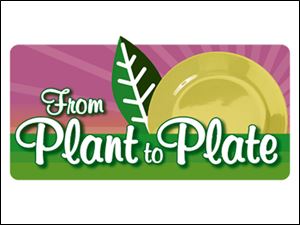
From Plant to Plate
Leafy greens versatile in salads
7/14/2012
Although they're called "leafy greens" they come in a variety of colors, from bright green to dark green with tones of red, purple, and white. Chard comes in a rainbow variety, including stems in neon orange, yellow, and pink. Some like lettuce and spinach are frequently eaten as fresh salad and others such as collards and kale are most often cooked before eating.
All varieties are versatile for many different healthy dishes.
One advantage of growing a few different kinds of greens is that the different varieties can handle a range of temperatures. Right now, it is too hot for tender, cool-weather greens like lettuce and spinach. If they are still growing they may be "bolting" or going to seed and the leaves taste bitter. On the other hand, it is about time for gardeners to replant seeds for a fall harvest. Some of the greens that can take the current heat include: chard, kale, and collards. These will continue to grow through the summer and can handle a light frost in the fall.
Most leafy greens are planted as seeds, although some could also be planted as transplants like kale, lettuce, chard, and collards. For a fall planting, direct seed about two to three months before the fall frost date. Although we can't predict the exact weather or number of days from now until the first frost, try these recommendations for fall planting: collards in mid-July, chard and mustard greens from mid-July through early August, lettuce from July through the end of August, and spinach in late August.
Watering is essential for seed germination as well as established plants. Greens, like many vegetables, need about an inch of water per week either from rain or watering. They can be watered using watering cans, soaker hoses, or sprinkler irrigation. Mulching 3-4 inches deep with herbicide-free grass clippings, weed-free straw, or other organic material helps retain soil moisture and helps suppress weeds. Control weeds by hand pulling or cultivation with a tool like a hoe but do not dig too close to the plants.
Leafy greens have few significant problems but keep an eye out for insects like flea beetles, aphids or cabbage worms. Cercospora leaf spot causes circular yellow spots on the leaves of chard, collards and kale. Remove infected leaves from the plant and avoid overhead sprinkler watering to reduce the spread of the disease.
Kale and collards can grow without being harvested until after the first frost in the fall. Some people prefer to do it this way for sweeter leaves. Other gardeners opt to harvest kale and collards throughout the summer and fall by breaking off the outer or bottom leaves of the plants when they are about 6-10 inches long and letting the center leaves keep growing for an on-going harvest.
This is the way many other greens are harvested as well. Single leaves can be picked as soon as they reach a usable size. For lettuce and spinach this is about 2-4 inches depending on the variety and intended use. Spinach, chard and some leaf lettuce varieties produce new leaves, especially if individual leaves are harvested at the "baby" stage, so multiple harvests are possible.
Wash greens under cool running water. For salads, "dry" the leaves in a salad spinner or blot with a paper towel. Remove stems, if necessary. Store greens in a perforated plastic bag in the refrigerator and use fresh within three to seven days. If you have a great abundance of greens and plan to store some for the rest of the year, consider freezing. Although greens like chard, collards, kale and spinach can be canned safely, freezing is recommended as the preferred way for home food preservation because it offers a higher quality product. There are many recipes for using greens from adding them to sandwiches and salads, to side-dishes and soups as well as smoothies.
Patrice Powers-Barker is an OSU Extension Educator, Family & Consumer Sciences.